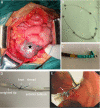Case report: Rupture of an ileus tube in a patient with recurrent rectal cancer
- PMID: 38162506
- PMCID: PMC10755397
- DOI: 10.3389/fonc.2023.1270728
Case report: Rupture of an ileus tube in a patient with recurrent rectal cancer
Abstract
The insertion of an ileus tube is an important treatment for intestinal obstruction. According to previous reports, jejunal intussusception has been reported as a complication associated with ileus tube placement. However, rupture of the weighted tip of an ileus tube has not been reported before. Herein, we report a 55-year-old Chinese woman who underwent radical proctectomy (DIXON) for rectal cancer and developed pelvic recurrence and lung metastasis 65 months after surgery, accompanied by symptoms of acute intestinal obstruction. An ileus tube was inserted before the operation (extensive total hysterectomy, bilateral adnexal resection, rectal Hartman operation, partial enterectomy, and intestinal adhesion lysis). Rupture of the ileus tube occurred after the operation and was treated with paraffin oil and enteral nutrition, and the metal beads and spring were eliminated through the colostomy. During the follow-up, the patient received targeted therapy plus immunotherapy, which was successful: the quality of life of the patient was excellent, and no obvious abnormal symptoms were found. Endoscopy-assisted ileus tube insertion should be performed under intravenous anesthesia, and a knot should be tied at the tip of the ileus tube before insertion so that the ileus tube can be inserted easily by grasping the thread with biopsy forceps(the "thread-knotting" method). With the above methods, the procedure of ileus tube insertion could be improved to reduce the incidence of tube-related rupture.
Keywords: complication; ileus tube; intestinal obstruction; rectal cancer; recurrence or metastasis.
Copyright © 2023 Ma, Jiang, Zhou, Wang, Zhao and Zhang.
Conflict of interest statement
The authors declare that the research was conducted in the absence of any commercial or financial relationships that could be construed as a potential conflict of interest.
Figures



Similar articles
-
Strategy to small intestine obstruction caused by Crohn's disease on the basis of transnasal ileus tube insertion.BMC Surg. 2022 May 14;22(1):183. doi: 10.1186/s12893-022-01632-w. BMC Surg. 2022. PMID: 35568851 Free PMC article.
-
Jejunal Intussusception Caused by a Nasointestinal Ileus Tube.Eur J Case Rep Intern Med. 2022 Feb 9;9(2):003161. doi: 10.12890/2022_003161. eCollection 2022. Eur J Case Rep Intern Med. 2022. PMID: 35265548 Free PMC article.
-
Clinical characteristics of nasointestinal ileus tube-induced intussusception: three case reports and a literature review.J Int Med Res. 2020 Apr;48(4):300060519878356. doi: 10.1177/0300060519878356. Epub 2019 Dec 25. J Int Med Res. 2020. PMID: 31875743 Free PMC article.
-
[A case of intussusceptions at two parts of the ileum caused by an ileus tube].Nihon Shokakibyo Gakkai Zasshi. 2017;114(6):1001-1007. doi: 10.11405/nisshoshi.114.1001. Nihon Shokakibyo Gakkai Zasshi. 2017. PMID: 28579583 Review. Japanese.
-
Palliative Chemotherapy: Does It Only Provide False Hope? The Role of Palliative Care in a Young Patient With Newly Diagnosed Metastatic Adenocarcinoma.J Adv Pract Oncol. 2017 May-Jun;8(4):382-386. Epub 2017 May 1. J Adv Pract Oncol. 2017. PMID: 30018843 Free PMC article. Review.
References
Publication types
LinkOut - more resources
Full Text Sources

